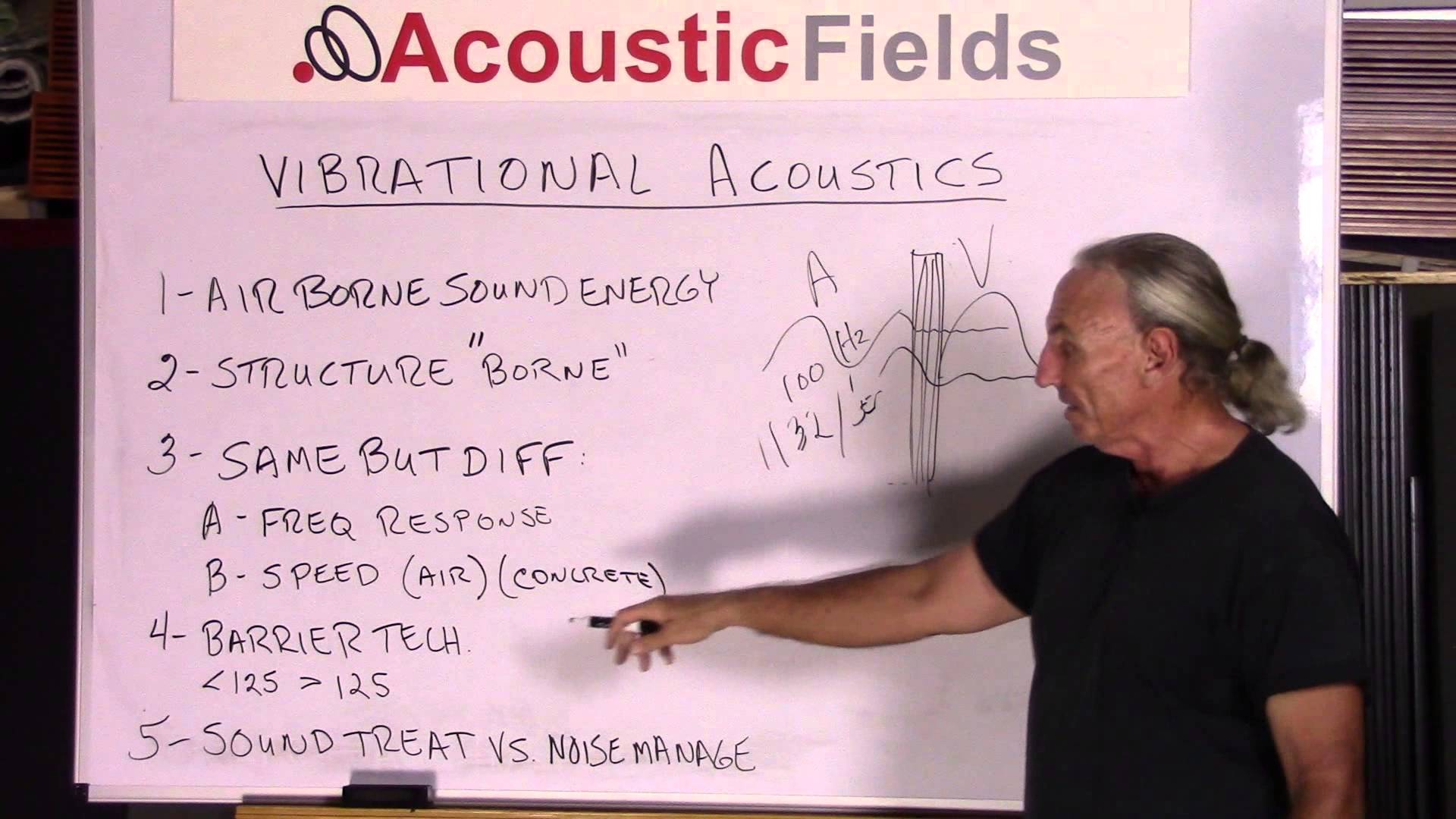Today, we’re going to talk about vibration acoustics and about the difference between vibration and room acoustics. So let’s start with some definitions. Airborne sound energy, we’re all familiar with that, you’re actually hearing that right now, hearing the energy coming out of my mouth being transmitted into the room it’s being picked up by a microphone but that’s a whole other electronic process.
So it’s energy that is created by vibration that travels through the air so no difference or difficult concepts to understand here. Structure “borne” vibration is a little bit different. When that airborne energy then strikes a structure, it changes and converts to more of a vibrational energy.
Vibration acoustics and airborne energy
Now, the signatures of airborne versus vibrational energy are a little bit different. They’re similar because they’re both sound energy but they’re a little bit different in some variables. Let’s look at a few of those variables.
The frequency response is obviously their signature. If you’re travelling through the air in your sound wave and then you strike a surface, then you become more vibrational energy and you’re going to look different. It’s like hitting a wall. When cars hit walls they look different, they change their shape. Well, it’s kind of a drastic example but I think you get the point when that airborne energy hits that wall, its looks change, it’s frequency responses change and that depends on a lot of factors in the wall and also how much energy is striking it.
The speed, obviously airborne energy we know is 1,132 feet per second. Okay, so we know that. When the energy strikes the surface and hits a solid then we have to now add in the density of the solid to the speed calculation and obviously it’s going to be slower. Air is much less dense than concrete, wood or almost any other substance so we get a speed variant in that.
So we get a frequency response difference and a speed difference. Those two things are really important in constructing barrier technology.
What does barrier technology do?
It does exactly what the below graphic I’m pointing to shows below. It takes airborne energy and converts it to vibrational energy and through the process created inside the barrier, not only changes the signature the frequency response, because we already discussed that just by hitting the wall that’s happening, but when you design the wall correctly, you can take maybe a signature that goes as shown in the following graphic and get it pretty smooth.
So the composition of the wall has a lot to do with the speed and the frequency response of the signature. I hope this isn’t too complicated as I’m trying to make it as simple as possible. The energy on one side of our wall is really different then now it converts back to acoustic energy on the other side but this process here is vibrational.
So when we build our barriers within our rooms to keep sound in and keep the outside sound from coming in. Both are critical. We’ve got a break point of about a 125 cycles. The technology requirements to stop energy hundred cycle energy coming in requires the use of barrier construction that is vastly different than energy above a 125 cycles. It’s about 3 times the cost, 3 times the weight and requires much more installation methodology.
So that’s why test, to find out what the strength and what the frequency is of the noise that we’re dealing with in outside situations. So that defines really what frequencies we’re trying to stop and what amplitude they are. How much barrier technology we incorporate, how we build it. So its a layering technique and we’ll talk about that sometime in another video.
Sound treatment versus noise management, don’t confuse them with vibration acoustics. Don’t confuse sound treatment, absorption and diffusion technology with noise management treatment such as barrier technologies. Barrier technologies keep sound out, they keep the sound in the room in. Treatment technologies just deal with the sound energy within the room.
Two different sciences, two different treatments, two different ways to go so don’t confuse those. Foam will not stop bass, foam will not stop low end energy so there’s a big urban myth that confuses sound treatment and noise management technologies.
In Summary
I hope this discussion helped clarify some concepts. If you want to learn more about this subject please sign up for our free room acoustic treatment videos and ebook which provide step by step instructions on all major room acoustic issues. Get instant access by signing up now. If you would like your room acoustic issues analysed for free by me then please fill in the form here and I will be happy to take a look for you.
Thanks
Dennis









We use broadband absorption in the two most critical frequency regions in small rooms. Our Diaphragmatic absorbers, ACDA series, have…
Interesting web site and provocative introduction. Please check your copy for typos, otherwise nicely presented. I would like to see…
There is no such thing as soundproof anything especially carpet. Low frequency noise transmission requires a permanent construction fix with…
Hello Dennis! Our neighbors put a Ice Bath in their garage which is right below our bedroom and the Low…